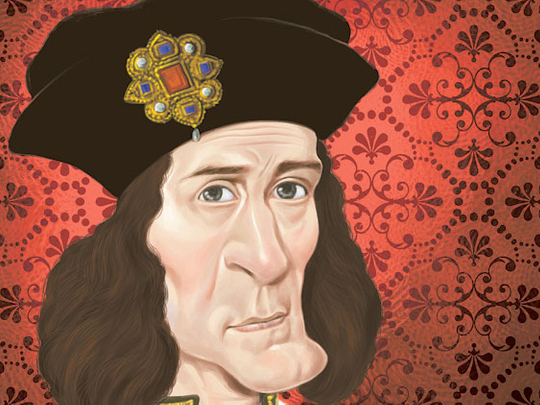
Sometimes, in the mornings, my wife turns on Fox Television and its news network. It’s brash and biased and blares out blathering and banal commentators on the day’s events. Sadly, there are many who believe it to be true.
In his day, you can argue that William Shakespeare was the Fox News network — his version of fiction was taken as the truth — though written more eloquently than the diatribe beamed from our flat-screen television. Willie had a way with words, a propagandist of sorts. And it is Willie who has shaped our view of poor old Richard III.
Richard has been dead since August 22, 1485, killed at the Battle of Bosworth Field when a battleaxe shattered his skull. So ended the three-century reign of the House of Plantagenet over England, heralding the rise of the House of Tudor, and bringing about a swift and bloody conclusion to Richard’s two years on the throne. Richard’s demise is also considered to be the end of the Medieval period in Britain, when feudal lords feuded, plague plagued most and the peasants were simply revolting.
With the Tudors on the throne after the War of the Roses ended that day on Bosworth Field, there was no way that an aspiring playwright and poet, who wanted to keep his head on his shoulders — literally, given the punishment for treason at the time — would write as much as a positive comma about poor old Richard III.
“Sin, death and hell have set their marks on him,” Shakespeare wrote in his Richard III, then describing him as a hunchback with a twisted spine and an evil disposition and forging a common perception that he had plotted and schemed his way to the throne.
Richard III and Macbeth are arguably the Bard’s two best plays, but Richard III has been performed more with greater adaptations. It is a plot of good and evil and has delivered more quotable lines than any other work.
As he flounders around Bosworth Field, the battle slipping away before his eyes, Richard laments: “A horse, a horse. My kingdom for a horse.”
His death comes moments later in a thrilling climax of stagecraft, slain by Henry VII to begin the Tudor reign. Applause, and exit stage left.
Adding to the intrigue is a popular fable that before the battlefield an old woman — no word on whether she was condemned to perish on the stake for witchcraft — predicted that Richard’s spur would strike and buttress a bridge on his way to battle and it would be on that spot that the fallen king would strike his head as he returned in death from Bosworth Field. Fable has it that was indeed the case.
And it is through Shakespeare’s hatchet job that Richard is accused of ordering the death of the two princes, his nephews, at the Tower of London. There is little historical evidence to suggest this was indeed so, but they had been declared illegitimate heirs produced from an improperly solemnised marriage, enough to ratify them as threats at a time when England was riven by decades of feuding between the Houses of York and Lancaster. Look today at England’s rugby shirts, at the emblem of roses, and you will still see the heraldic consequences of that struggle.
But enough of propaganda. What of the real Richard III?
What is known is that he convened one parliament in his two-year reign and was actually an enlightened social reformer — he moved tax reforms and introduced the concept of bail, that an arrested man had the right to be freed while awaiting trial — as long as he was of noble standing and property. That same principle applies now.
Thanks to modern science, carbon dating and DNA analysis, the bones of Richard III were positively identified last week. They had been discovered six months ago under a car park in Leicester.
After the battle, Richard’s naked body was tossed in a small grave in the grounds of a Greyfriars monastery. During the dissolution of the monasteries under the reign of Henry VIII, it was popularly reported that his bones were thrown into the nearby river, a suitable end to a monarch whose death ushered in the Tudor era.
Thanks to science, we now know Richard III had but a gently curved spine, but suffered horrific post-mortem mutilation.
And we at last have a more complete picture of his reign. So much for Shakespeare. Now, if only academics can just dispel the drama on Fox ...












